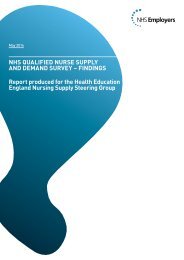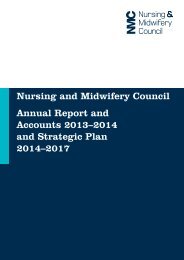Journal_1_2014_final_WEB
Journal_1_2014_final_WEB
Journal_1_2014_final_WEB
You also want an ePaper? Increase the reach of your titles
YUMPU automatically turns print PDFs into web optimized ePapers that Google loves.
Scientific Communication<br />
Inclusion and exclusion criteria<br />
Inclusion<br />
Patients >18 yrs-old suffering from at<br />
least one of three chronic diseases:<br />
COPD, diabetes, or CHF<br />
Patients having cognitive limitations<br />
took part with help from relatives<br />
Exclusion<br />
Non-English-speaking patients<br />
Patients without telephone access<br />
Comorbidity was not an exclusion criteria<br />
Inclusion<br />
Patients willing to take part in supplemental<br />
questionnaires in addition to the above<br />
criteria [8]<br />
Exclusion<br />
As above [8]<br />
Inclusion<br />
Patients willing to take part in supplemental<br />
questionnaires in addition to the above<br />
criteria [8]<br />
Exclusion<br />
Patients with cognitive limitations;<br />
otherwise, as above criteria [8]<br />
Patient characteristics<br />
at study start<br />
Telemedicine<br />
n=1,625<br />
Average age=70.9 yrs<br />
Control group<br />
n=1,605<br />
Average age=69.7 yrs<br />
Patients with COPD=48%<br />
Patients with diabetes=24%<br />
Patients with CHF=28%<br />
Telemedicine<br />
n=845<br />
Average age=70.1 yrs<br />
Control group<br />
n=728<br />
Average age=70.6 yrs<br />
Telemedicine<br />
n=534<br />
Average age=70.0 yrs<br />
Control group<br />
n=431<br />
Average age=70.1 yrs<br />
– –<br />
Inclusion<br />
Patients who did not want to partake [8]<br />
Average age=71 yrs<br />
Randomization<br />
The WSD was designed as a cluster-randomized study.<br />
Every general practice (N=238) in three UK regions were<br />
requested to take part and 179 of these (75.2%) accepted.<br />
Randomization of the general practices was performed<br />
centrally using an algorithm that ensured an equal distribution<br />
according to practice size, geographic area, deprivation<br />
index, proportion of non-white patients, and<br />
prevalence of the major chronic diseases (i.e., chronic lung<br />
disease, chronic heart disease, and diabetes).<br />
Intervention<br />
Patients in the control group were offered usual treatment,<br />
while patients in the intervention group were additionally<br />
offered telehealth. Telehealth includes a broad class of<br />
technologies, but all patients had a base unit and tools to<br />
measure weight (heart failure), pulse oximetry (COPD),<br />
and blood glucose (diabetes). The patients performed<br />
measurements up to 5 days per week. Questions regarding<br />
symptoms and information concerning patient education<br />
were forwarded to all participating individuals. Data from<br />
these measurements were sent to monitoring centres and<br />
handled by specially educated nurses. Each region was<br />
supplied with different technologies and service models 9 .<br />
Risk of bias<br />
In existent papers on clinical and economic consequences<br />
of telemedicine 9-11 , the randomization sequence is<br />
described, data completeness is detailed, and results descriptions<br />
are based on the protocol. However, patient<br />
allocation is not hidden to investigators and statisticians,<br />
and the patients are not blinded to their treatment group.<br />
Clinical effects<br />
In the study addressing use of secondary care and mortality,<br />
the primary endpoint was the number of patients<br />
admitted to hospital during a 12-month period 9 . Sample<br />
size was calculated from an expected admission reduction<br />
of 17.5%, and the study was based on registry data.<br />
Between May 2008 and December 2009 a total of 3,230<br />
individuals were recruited. No statistically significant differences<br />
among patients in these two groups were found<br />
at baseline.<br />
The use of hospital services was generally lower in intervention<br />
group versus control group patients (Table 2). The<br />
number of admitted patients accordingly was found to be<br />
<br />
Table 2. Hospital use and mortality after 12 months a<br />
Control group<br />
(n=1,584)<br />
Intervention<br />
group<br />
(n=1,570)<br />
Percentage<br />
difference<br />
(95% CI)<br />
Admission proportion 48.2% 42.9% -10.8 (-18.0-3.7)<br />
Mortality 8.3% 4.6% -44.5 (-65.3-23.8)<br />
Emergency admissions/person 0.68 0.54 -20.6 (-33.8-7.4)<br />
Elective admissions/person 0.49 0.42 -14.3 (-30.6-2.0)<br />
Outpatient attendances/person 4.68 4.76 +1.7 (-8.3-11.8)<br />
Emergency department visits/person 0.75 0.64 -14.7 (-28.0-1.3)<br />
Bed days/person 5.68 4.87 -14.3 (-32.4-3.9)<br />
DRG Tariff costs/person 2448b 2260 DKK -7.7 (-19.4-4.0)<br />
CI=Confidence interval. a Based on [9, Table 3]. bPrice level 2009: 1 GBP=8.232 DKK.<br />
EWMA <strong>Journal</strong> <strong>2014</strong> vol 14 no 1 45




